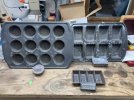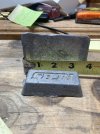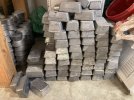Snakeoil
Well-Known Member
So, I have been given some lead by fellow shooters at the club. The sources vary. I used pencils to test hardness and thought it was mostly about a 25:1 alloy equivalent. Who knows what the alloy actually is. I found I had to hit the varioius ingot with a file to get a new, clean surface for my pencils to get a good reading. If I tried using them on the oxidized exterior, the 6B would skate off, giving the impression that the lead was not pure lead. So, most tested at 25:1 so I tossed it all in my big propane melting pot and mixed it all together. When I poured ingots I tested them and they all tested to be pure lead. Does lead age harden that much if it is pure lead to give a hardness reading similar to 25:1?
The other interesting tidbit, is I had two big pieces that tested as pure lead. Once was a square 5 lb. plumbers ingot marked as caulking lead. The other was a 1 inch thick slab that supposedly came out of some lab. I cleaned the pot and put those two in together. When they melted, the color of the dross was bizarre. It looked like molten gold. It would change colors and since I'm red/green color bling I asked the wife to take a look. She said it looks like gold, brass and copper, depending on where she looked. It all pretty much came off as dross.
Here are some pics of the dross. The color changed as it cooled.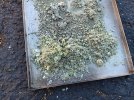
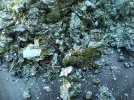
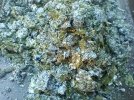
And along with this strange dross, the ingot all came out blue. Some are all blue, other are like a marbleized blue. My only guess is there was a trace element in that thick slab intended to dissuade theft. GE used to put trace elements in their copper because employees would steal it to scrap it for the money. Here's a pic of the ingots. The ones at the top are not the same alloy. The ones below those are the blue ingots. You can see marbleizing.
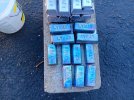
Anybody have any idea what the dross and blue color is???
The other interesting tidbit, is I had two big pieces that tested as pure lead. Once was a square 5 lb. plumbers ingot marked as caulking lead. The other was a 1 inch thick slab that supposedly came out of some lab. I cleaned the pot and put those two in together. When they melted, the color of the dross was bizarre. It looked like molten gold. It would change colors and since I'm red/green color bling I asked the wife to take a look. She said it looks like gold, brass and copper, depending on where she looked. It all pretty much came off as dross.
Here are some pics of the dross. The color changed as it cooled.



And along with this strange dross, the ingot all came out blue. Some are all blue, other are like a marbleized blue. My only guess is there was a trace element in that thick slab intended to dissuade theft. GE used to put trace elements in their copper because employees would steal it to scrap it for the money. Here's a pic of the ingots. The ones at the top are not the same alloy. The ones below those are the blue ingots. You can see marbleizing.

Anybody have any idea what the dross and blue color is???

